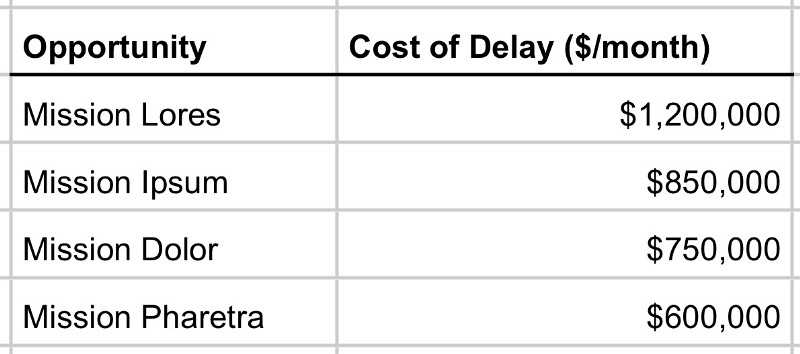Let’s take a list of opportunities. For each opportunity I am going to describe the opportunity cost per month (Cost of Delay).
The list is in descending order by Cost of Delay.
Now, any self-respecting product manager is going to look at that list and say:
That’s all well and good, but what if Mission Pharetra can be finished in 1 month, and Mission Lores will take 5 months … shouldn’t we do Mission Pharetra first?And that is sound thinking. But let me go up a level here.
Say we are a product development org of 50, and we are thinking about how to structure our organization to optimize for value throughput. We see the list above. We notice that Mission Lores is the most valuable opportunity (when viewed solely from a cost of delay perspective, diseregarding duration). With this in mind, we decide to swarm on Mission Lores, and also tool up specifically for efforts like Mission Lores. We also notice that there may be an 80/20 rule in effect. After three weeks, it should be possible to extract 80% of the Mission Lores value.
Well now, Mission Lores might be the better choice!
So, let’s try to divide out what we’re talking about here:
- Opportunities to create value
- Maximizing value throughput Put differently, it is easy to miss the forest through the trees when we make assumptions about duration/level of effort and its impact on “value”. Product managers (and “the business”) are constantly asking for “level of effort”…so much so that they often forget to mention what is truly valuable devoid of their assumptions about effort.
Let’s add something to our list.
 Case in point, as a CTO or CPO, you would likely structure your organization a bit differently knowing that this was “the list”. If this list was foisted on your org, and your org was NOT optimized for this sequencing, you might not be able to pull in value order (yet)
Case in point, as a CTO or CPO, you would likely structure your organization a bit differently knowing that this was “the list”. If this list was foisted on your org, and your org was NOT optimized for this sequencing, you might not be able to pull in value order (yet)
.
This is where I’m going with all this.
By stating opportunities in unweighted terms (unweighted by effort) we make very explicit the value of opportunities. These are THE PRIORITIES. Priorities are distinct from work sequencing or maximizing value throughput. The product development org/department — given high level business priorities — is responsible for maximizing value throughput which involves 1) extracting the value from opportunities, and 2) the duration of the opportunities. When those high level priorities change, they must adapt to optimize for a new “composition” of the list…but if we forget what is important, and only view what is immediately feasible, we risk (again) losing sight of what is truly valuable.
CD3 (weighted cost of delay) and WSJF (weighted shortest job first) are very valuable for determining sequence. But try to preserve a list sorted purely by value as a reminder.
Let me close with a tweet:
